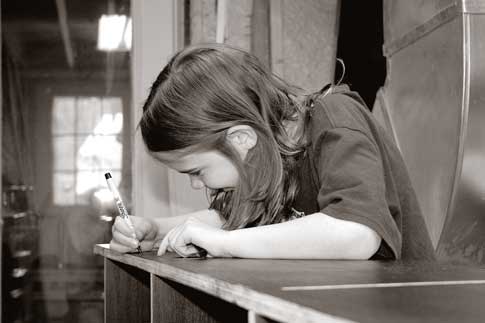
Now that shop class is as common in high schools as poodle skirts, lots of woodworkers worry about passing on our enthusiasm for the craft to the next generation. In my house, I’ve started treating my kids more like apprentices, and it seems to be working.
They help clean the shop. They assist me on projects at assembly time. They can work on their own projects on the side when I don’t need them. And – here’s the odd part – I pay them (a pittance) for their help and swear them to secrecy on the “arts and mysteries” of the craft.
This weekend has been a perfect example. I assembled a large run of shelving that I plan to install in the recipient’s home this week. There was a lot of tedious gluing, clamping and clean-up work involved, so I hired 7-year-old Katy to help.
First, I showed her the “secret” to making the lacquer finish perfectly smooth to the touch – a folded up brown paper bag. We rubbed all the surfaces vigorously, which knocked down any surface imperfections without cutting through the film finish. Katy did the shelves; I did the uprights.
“Cool,” she said. “It works!”
As we were bagging the lacquer, both of us noticed that there were some small dings and scratches in the color. This is was the result of the parts getting moved around more than I like. So I swore Katy to secrecy again and introduced her to the mystery of stain pens. In this case, the best match wasn’t one of my stain pens (which I keep hidden away), it was a black Sharpie marker.
In fact, Katy became incredulous when I took her picture at work with the marker.
“What if someone sees the picture and figures out our secret?” she asked. “Then they’ll know!”
Then we glued up the shelves. I applied the glue. Katy added the Dominos. We both applied the clamps and cleaned the glue squeeze-out. Assembly can be stressful for me, but Katy’s amazement at how the project came together kept my anxiety in check.
We did four major glue-ups this weekend, and by the fourth one, Katy dove into the work like she had been doing it all her life. I wonder if learning woodworking is like learning a foreign language – it might be easier when you are young.
As I added the kicks to the cabinet, Katy worked at the bench at her own project – she’s transforming my discarded shop jigs for this shelving project into a wooden alligator.
Then I paid her (about $1 an hour for the shop time) and I asked her if she’d come along on the installation next week. With hesitation, she said: “Yes! Hurray!”
Next step: Getting the apprentices to fetch the small beer for the master.
— Christopher Schwarz